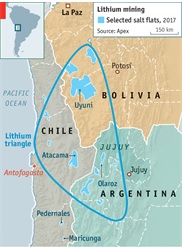

Context
India's KABIL, a mining joint venture between state-run firms National Aluminium Co, Hindustan Copper Ltd and Mineral Exploration Corp Ltd, has signed a preliminary agreement with Australia's Critical Minerals Facilitation Office (CMFO).
- The objective is to explore lithium and cobalt mines in Australia.
About
- India has committed to jointly invest $6 million with the Australian government to explore lithium and cobalt mines in Australia over the next six months.
- India is offering $2.4 billion of incentives for companies to build battery cells locally for electric vehicles.
- The agreement also provides for inclusion of any other Indian state-run firm as an investment partner, and envisages the due diligence process will be completed and further investment decisions taken over the next six months.
|
KABIL
|
About Cobalt
- Cobalt is an essential trace element, and forms part of the active site of vitamin B12.
- Cobalt is a hard, brittle metal.
- It is similar in appearance to iron and nickel. Cobalt has a magnetic permeability around 2/3 that of iron.
- Cobalt is found as a mixture of two allotropes over a wide temperature range.
|
Cobalt in India Occurrences of cobalt are reported from Singhbhum district, Jharkhand; Kendujhar and Jajpur districts, Odisha; Jhunjhunu district, Rajasthan; Tuensang district, Nagaland; and Jhabua and Hoshangabad districts, Madhya Pradesh. |
About Lithium:
- Lithium is a chemical element with symbol Li and atomic number 3.
- It is a soft, silvery-white alkali metal.
- Under standard conditions, it is the lightest metal and the lightest solid element.
- Lithium is highly reactive and flammable, and is stored in mineral oil.
- It never occurs freely in nature, but only in (usually ionic) compounds, such as pegmatitic minerals, which were once the main source of lithium.
- Due to its solubility as an ion, it is present in ocean water and is commonly obtained from brines.
- Lithium metal is isolated electrolytically from a mixture of lithium chloride and potassium chloride.
- Lithium is a key component used in Electric Vehicle batteries. And India, through its ? 18,100- crore PLI scheme is o?ering incentives for companies to build battery cells locally.
- China and Hong Kong are the biggest lithium battery suppliers to India.
|
Lithium Triangle:
|


